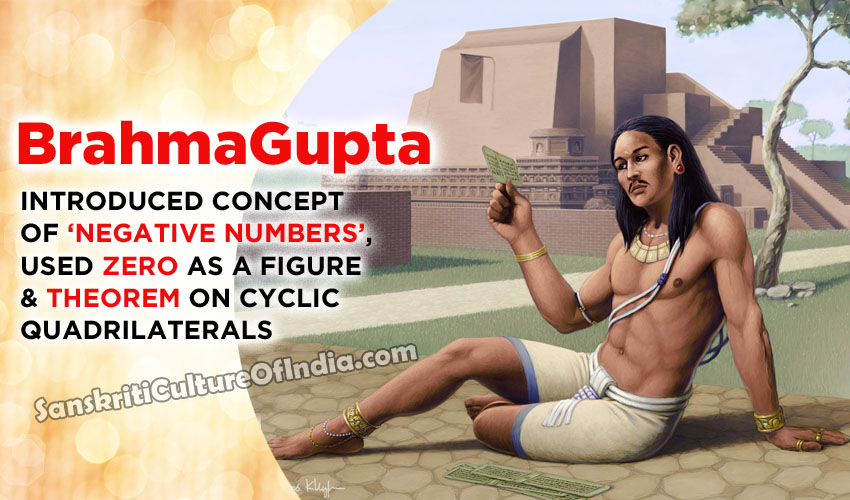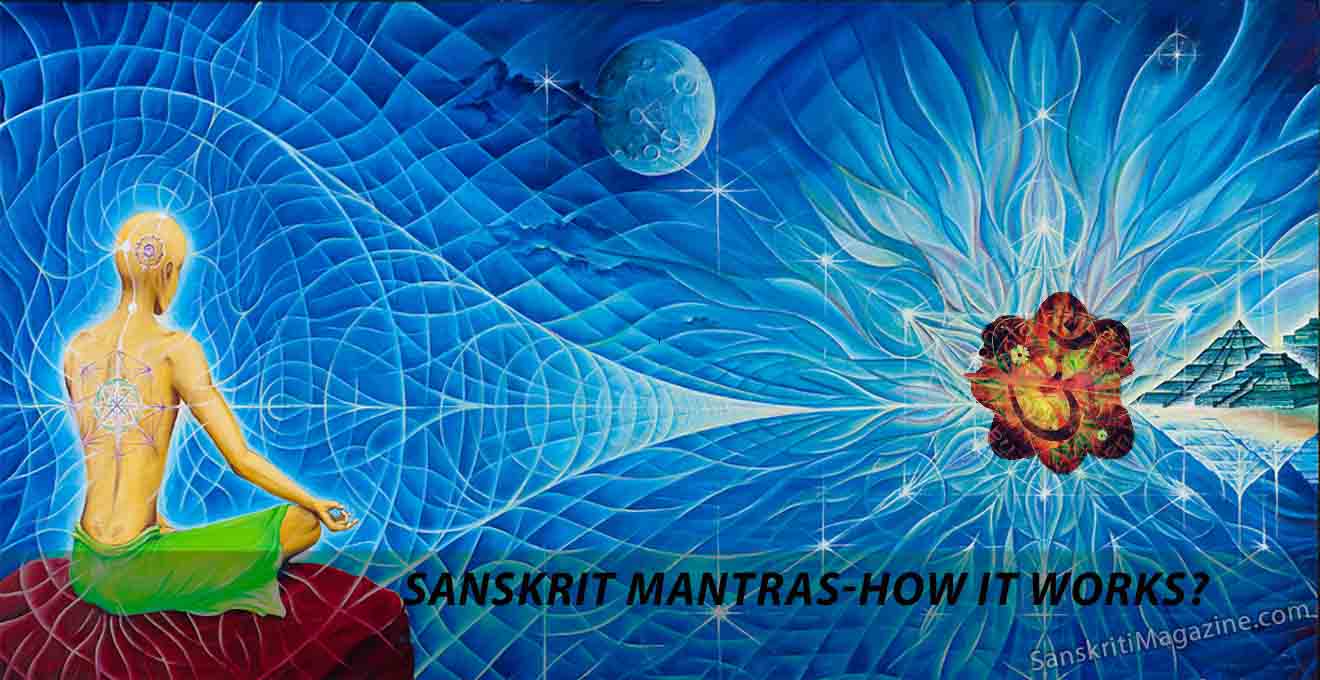Brahmagupta (Sanskrit: ब्रह्मगुप्त), the son of Jisnugupta, was an Indian mathematician and astronomer who lived between 597–668 AD and wrote two important works on mathematics and astronomy:
- Brāhmasphuṭa Siddhānta in 628 AD (Correctly Established Doctrine of Brahma, also called The Opening of the Universe) which is a theoretical treatise
- Khaṇḍakhādyaka, a more practical text
He is believed to be born in Bhinmal (in Hindi भीनमाल, which was originally known as Bhillamala in ancient days), in present day Rajasthan and was known as Bhillamalacarya (the teacher from Bhillamala). Brahmagupta became the head of the astronomical observatory at Ujjain which was the foremost mathematical centre of ancient India at this time. Outstanding mathematicians such as Varahamihira had worked there and built up a strong school of mathematical astronomy.
Brahmagupta was the first to give rules to compute with zero.
Most of his works are composed in elliptic verse, a common practice in Indian mathematics at the time, and consequently have something of a poetic ring to them. But since no proofs are given (found), it is not known how Brahmagupta’s mathematics was derived.
The historian al-Biruni (c. 1050) in his book Tariq al-Hind states that the Abbasid caliph al-Ma’mun had an embassy in India and from India a book was brought to Baghdad which was translated into Arabic as Sindhind. It is generally presumed that Sindhind is none other than Brahmagupta’s Brahmasphuta-siddhanta. That is how an important link between Indian Mathematics, Astronomy and the nascent upsurge in science and mathematics in the Islamic world formed.
Brahmagupta’s work in Mathematics:
In his work on arithmetic, Brahmagupta explained how to find the cube and cube-root of an integer and gave rules facilitating the computation of squares and square roots. He also gave rules for dealing with five types of combinations of fractions. He gave the sum of the squares of the first n natural numbers as n(n + 1)(2n + 1)⁄ 6 and the sum of the cubes of the first n natural numbers as (n(n+1)/2)2.
Use of ZERO:
Brahmagupta stated that ‘When ZERO is added to a number or subtracted from a number, the number remains unchanged. A number multiplied by ZERO becomes ZERO.
Positive and Negative numbers usage :
His statements about debt (negative numbers) and fortune(positive numbers) are:
- A debt minus ZERO is a debt
- A fortune minus ZERO is a fortune
- Zero minus Zero is a Zero
- A debt subtracted from Zero is a fortune
- A fortune subtracted from Zero is a debt
- Zero multiplied by debt or fortune is a Zero
- Zero multiplied by Zero is a Zero
- Product (multiplication) or Quotient (division) of two debts is a fortune
- Product of Quotient of two fortunes is a fortune
- Product of Quotient of a debt and a fortune is a debt
Brahmagupta established the basic mathematical rules for dealing with zero (1 + 0 = 1; 1 – 0 = 1; and 1 x 0 = 0), although his understanding of division by zero was incomplete (he thought that 1 ÷ 0 = 0). Almost 500 years later, in the 12th Century, another Indian mathematician, Bhaskara II, showed that the answer should be infinity, not zero (on the grounds that 1 can be divided into an infinite number of pieces of size zero), an answer that was considered correct for centuries. However, this logic does not explain why 2 ÷ 0, 7 ÷ 0, etc, should also be zero – the modern view is that a number divided by zero is actually “undefined” (i.e. it doesn’t make sense).
Before Brahmagupta, the result of 3 – 4 was considered to have no answer or at the most as ’0′. But he introduced the idea of debt (negative numbers) and showed how to borrow and subtract to attain a negative number.
Furthermore, he pointed out, quadratic equations (of the type x2 + 2 = 11, for example) could in theory have two possible solutions, one of which could be negative, because 32 = 9 and -32 = 9. In addition to his work on solutions to general linear equations and quadratic equations, Brahmagupta went yet further by considering systems of simultaneous equations (set of equations containing multiple variables), and solving quadratic equations with two unknowns, something which was not even considered in the West until a thousand years later, when Fermat was considering similar problems in 1657.
Brahmagupta’s Theorem on cyclic quadrilaterals:
Brahmagupta dedicated a substantial portion of his work to geometry and trigonometry. He established √10 (3.162277) as a good practical approximation for π (3.141593), and gave a formula, now known as Brahmagupta’s Formula, for the area of a cyclic quadrilateral, as well as a celebrated theorem on the diagonals of a cyclic quadrilateral, usually referred to as Brahmagupta’s Theorem.
Astronomy:
Brahmagupta taught Arabs about Astronomy.
The famous Abbasid caliph Al-Mansur (712–775) founded Baghdad, which is situated on the banks of the Tigris, and made it a center of learning. The caliph invited a scholar of Ujjain by the name of Kankah in 770 A.D. Kankah used the Brahmasphutasiddhanta to explain the Hindu system of arithmetic astronomy. Muhammad al-Fazari translated Brahmugupta’s work into Arabic upon the request of the caliph.
In chapter 7 of his Brahmasphutasiddhanta, entitled Lunar Crescent, Brahmagupta rebuts the idea that the Moon is farther from the Earth than the Sun, an idea which is maintained in scriptures. He does this by explaining the illumination of the Moon by the Sun.
- 7.1. If the moon were above the sun, how would the power of waxing and waning, etc., be produced from calculation of the [longitude of the] moon? the near half [would be] always bright.
- 7.2. In the same way that the half seen by the sun of a pot standing in sunlight is bright, and the unseen half dark, so is [the illumination] of the moon [if it is] beneath the sun.
- 7.3. The brightness is increased in the direction of the sun. At the end of a bright [i.e. waxing] half-month, the near half is bright and the far half dark. Hence, the elevation of the horns [of the crescent can be derived] from calculation.
Some of the important contributions made by Brahmagupta in astronomy are:
Methods for calculating the position of heavenly bodies over time (ephemerides), their rising and setting, conjunctions, and the calculation of solar and lunar eclipses. [26]
He observed that the Earth and heaven were spherical and that the Earth is moving. In 1030, the Muslim astronomer Abu al-Rayhan al-Biruni, in his Ta’rikh al-Hind, later translated into Latin as Indica, commented on Brahmagupta’s work and wrote that critics argued:
“If such were the case, stones would and trees would fall from the earth.”
According to al-Biruni, Brahmagupta responded to these criticisms with the following argument on gravitation:
“On the contrary, if that were the case, the earth would not vie in keeping an even and uniform pace with the minutes of heaven, the pranas of the times. […] All heavy things are attracted towards the center of the earth. […] The earth on all its sides is the same; all people on earth stand upright, and all heavy things fall down to the earth by a law of nature, for it is the nature of the earth to attract and to keep things, as it is the nature of water to flow, that of fire to burn, and that of wind to set in motion… The earth is the only low thing, and seeds always return to it, in whatever direction you may throw them away, and never rise upwards from the earth.”
About the Earth’s gravity he said: “Bodies fall towards the earth as it is in the nature of the earth to attract bodies, just as it is in the nature of water to flow.“










